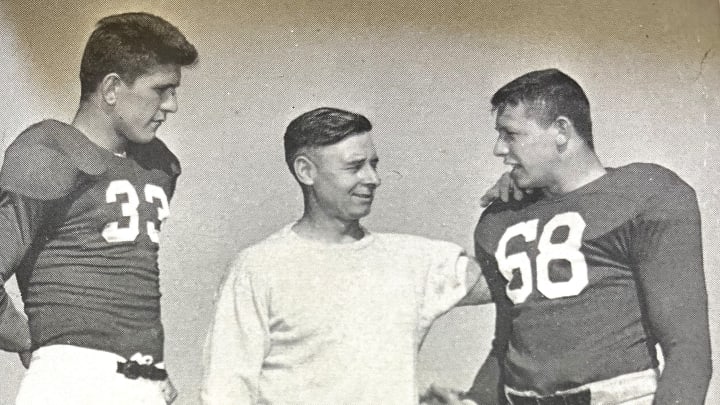Indiana Football Coaches, The First Year: Clyde Smith Had Big Shoes To Fill

In the 1948 Indiana University Arbutus yearbook, no purple prose was spared when describing the legacy of departed football coach Bo McMillin.
“When the Greyin’ Colonel came to Indiana in March 1934, the Hoosiers had never finished higher than third in Western Conference football.
“Then the man who made fools of Harvard football teams twice began to build teams that were to be heard throughout the nation. In 1945, the realization of the Hoosier dream came true. Indiana won the Big Nine Conference title without the aid of service personnel.”
Truth be told, Indiana has been chasing McMillan’s legacy ever since.
Curt Cignetti becomes the latest man to try to change Indiana’s football fortunes. Since 1948, when McMillin departed Bloomington with a 63-48-11 record, no Hoosier coach has compiled a winning record.
Thirteen coaches have come and gone. What were their legacies and, most relevant to Cignetti’s maiden voyage, how did their first seasons set the stage for their regime?
WHY CHANGE?
McMillin, who had also become Indiana’s athletic director, sought bigger challenges. He broke an Indiana contract that had seven years remaining to move to the NFL as coach and general manager of the Detroit Lions. It was front page news.
“Leaving college football after all these years pulls at my heartstrings,” McMillin said in an Indianapolis Star story from Feb. 20, 1948. “I can tell you truthfully I have been sweating blood for 10 days now making my decision to accept this position with the Lions.”
Indiana was left in a major bind with two vital positions to fill.
Paul Harrell becameathletic director, and one month after McMillin departed, Clyde Smith was named the Hoosiers’ new football coach.
ENTER SMITH
Smith was a hometown choice of sorts. Smith, 42, played for McMillin at Geneva College in the 1920s and was on McMillin’s Indiana staff as line coach from 1934-37.He left Bloomington to coach at La Crosse State – today’s Division III Wisconsin-La Crosse – and was 29-16-2 in seven war-interrupted seasons.
“Naturally, I am happy and grateful to come back to Indiana,” Smith said in an Indianapolis Star story from March 17, 1948. “I realize that it is a tremendous task.”
At the time, Smith had never been part of a losing season as a player or coach. Fondly remembered as a stocky and intense line coach in the 1930s, he was a popular hire.
“Now it’s time for Indiana alumni to breathe another sigh of relief,” said a March 1948 column in the Indianapolis News, referring first to Harrell being named athletic director. “Clyde Smith touches the spot.”
YEAR ONE
Straight away, there were challenges for Smith. Chief among them was that Indiana was shy on experienced personnel. The Hoosiers had to replace their quarterback and had only five seniors on the 22-man two-deep roster.
Indiana did have George Taliaferro, who would thrive in the single-wing attack Smith implemented. Taliaferro led the team in rushing and passing in 1948, part of his legacy as one of the greatest Hoosiers of all-time.
Still, not much was expected of the Hoosiers, but they producedsome early surprises.
Indiana opened the season as the underdog at Wisconsin, which had finished second in the then-Big Nine in 1947. The Hoosiers, forced five fumbles, and Taliaferro scored three touchdowns in a 35-7 upset of the Badgers.It was the largest margin of victory for an Indiana coach in his opening game until Bill Lynch coached the Hoosiers to a 48-point win over Indiana State in 2007.
Indiana followed that win with a 7-0 win at home against Iowa, who had beaten the Hoosiers in six of the previous seven contests. Taliaferro’s 5-yard touchdown run was the only score.
The Associated Press poll, which began after the season started in 1948, had Indiana ranked No. 17 in its first poll after the 2-0 start. Pundits were getting excited about the Hoosiers, even with their inexperience and lack of depth.
“Indiana’s future has seldom been brighter. And there’s nothing particularly dark about the present, except the uniforms,” said the Indianapolis News in an analysis of the Iowa game and in reference to the black uniforms the Hoosiers wore in the late 1940s.
That heady start would give way to a harsh reality. Indiana wouldn’t win another game in 1948.
After the Iowa game, Indiana lost 7-6 to Texas Christian in Bloomington as the Horned Frogs scored the winning touchdown in the final three minutes.
The season would snowball from there. Indiana would only come within a touchdown of its opponents in one more game, a 21-14 loss at Pittsburgh. The season ended with humiliating 54-0 and 39-0 defeats to Michigan and Purdue, respectively.
Indiana finished 2-7, but Smith was largely spared from criticism. The Hoosiers’ tough schedule was cited as the primary excuse for the worst Indiana season since 1938.
“We’ve talked to several alumni and the griping has been at a minimum. They seem to be willing to go along with the Hoosier boss and his staff in hopes that he’ll get a sound system going by next fall,” opined sportswriter Bob Stranahan in the Indianapolis Star.
That slow start for Smith would prove to be something he would never overcome. Smith finished his Indiana tenure with an 8-27-1 record after he resigned towards the end of the 1951 season. At the time of his departure, his .236 winning percentage was the worst in school history.
Related stories on Indiana football
- CIGNETTI HIRED: Look back to the day Curt Cignetti was hired as Indiana's football coach. CLICK HERE.
- CIGNETTI DRUMS UP EXCITEMENT: During Big Ten Football Media Days, Indiana football coach Curt Cignetti worked the room with his confident manner and sense of humor. CLICK HERE.
- INDIANA STARTS FALL CAMP: The Hoosiers began fall camp last Friday as the Curt Cignetti era begins in earnest. CLICK HERE.
